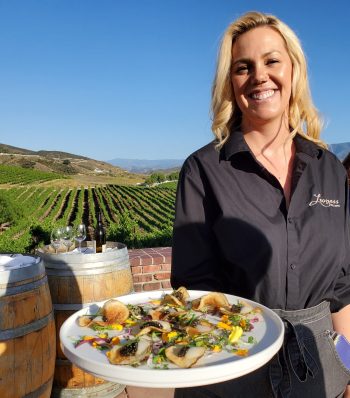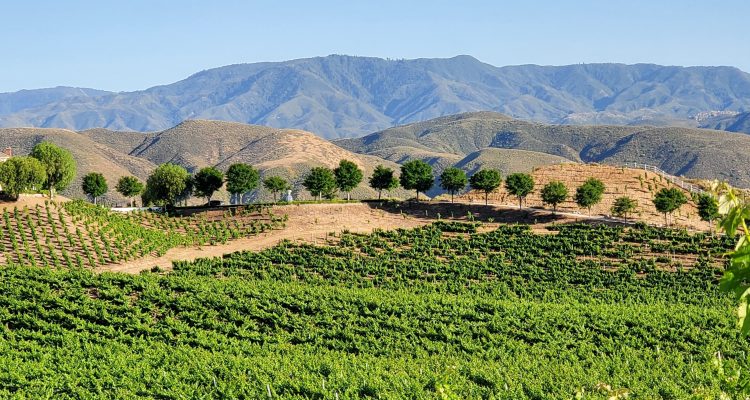Temecula Valley is ideal for wine country escapes. Called Southern California’s wine region, Temecula Valley is one of the best kept secrets in the galaxy of wine destinations.
An easy side excursion from San Diego or Los Angeles, the Temecula area is only an hour’s drive from Disneyland. Beyond wine tasting, the destination offers a growing choice of activities from hot air balloons to bike tours and wellness retreats. The historic small town of Temecula with dining and bar options and boutique shops is located a short drive away from the main hub of wineries.
With scenic views of picturesque vineyards and rolling hills, travelers can follow several Temecula Valley wine trails to guide the exploration of the region’s 47 wineries grouped along two main roads. The wineries craft an array of white, rosé and red wines from bubbles to blends and dessert options.
We’ll explore several of the wineries and highlight the unique ways they present their wine and special food options from gourmet restaurants to cafés. Since the tastings are generally lower-priced than other wine regions and most of the wines are sold in the tasting rooms or online rather than through national distribution, this wine country is worth an overnight stay or two.
A unique feature of Temecula Valley wine country is the availability of on-site accommodations at seven wineries ranging from large resorts to hotels and boutique B&Bs. During a recent media trip to the region, we stayed at Europa Village which encompasses a resort and three wineries. Visitors can stay in spacious rooms or casitas. You can travel the world of wine by tasting Italian varietals at Vienza, French offerings at C’est La Vie, or Spanish style wines at Bolero.
Like most wineries, Europa Village offers activities beyond tours and tastings from the Wine Cave Sound Bath experience to yoga in the vines and more. We savored an upscale dinner at Europa Village’s Bolero restaurant with a diverse set of pairings from the diverse selection of wines.
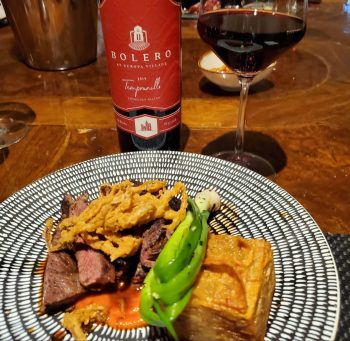
Before our winery tours began, we had a taste of the area’s many activities during an exciting motorcycle sidecar trip with Sidecar Tours Tememcula. I say exciting because neither myself nor my friend behind me in the double sidecar had ever ridden in a sidecar. We rode through Bella Vista vineyard where some of the oldest vines from the 1960s reside and stopped along the old stagecoach trail for an expansive view of Temecula Valley.
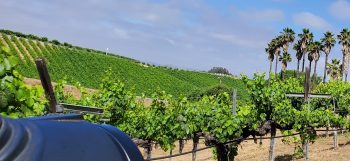
Doffo Winery
Speaking of motorcycles, what a treat to discover Doffo, a moto-themed winery. The founder, Marcelo Doffo, had a southern Calif. business restoring motorcycles when he discovered the beauty of Temecula Valley. In 1997 he bought a four-acre property and dreamed of making wine for the family. A few years before, Doffo had visited a Great Uncle in Piedmont, Italy, and learned winemaking basics.
With ownership of many more vineyard acres, the winery is known for unique red blends and unique tours. We took the signature Cork ‘N Torque tour in a jeep and drove up and down the vineyard hills, stopping at the top for a tasting with panoramic views.
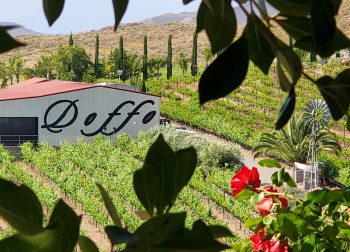
The barn-like tasting room has a sophisticated rural vibe—and motorcycles and their paraphernalia everywhere including a collection of 270 motorcycles and scooters spanning eight decades. The outdoor patio area is home to concerts and more. The winery hosts a well-known annual Taste of Argentina Tapas Party which relates to their maternal ancestry. Doffo Red Tinto blend with majority Malbec scored highest on my tasting sheet.
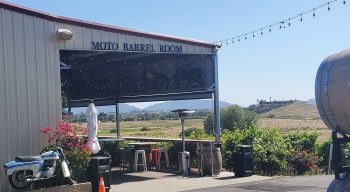
Leoness Winery
Attracted to fertile Temecula Valley, the South African owner of Leoness began farming there in 1972. After acquisition of vineyards in 1989, Leoness produced its wine in a two-car garage. The label of the winery’s top Signature Series wines displays hands working the soil. Tim Kramer, a former engineer, is the hands-on winemaker. Taking advantage of the Mediterranean climate, Kramer also grows avocados and citrus which thrive on the property. The tasting patio highlights the views of the rolling hills.
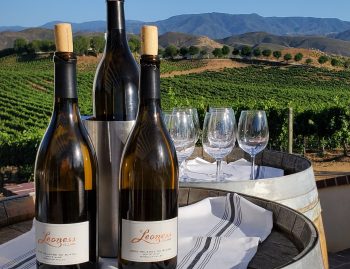
Tasting options range from a private hosting tour to cheese and wine pairings and a group tour and tasting. The winery hosts a restaurant with a large patio run by Chef Ben Diaz who prepares exceptional food to pair with Leoness wine. The salad course with burrata cheese and basil and tomato pesto matched up to the Leoness full-bodied Cinsault. Local halibut with wild mushroom risotto in an apricot port reduction paired very well with their Grand Mélange Rhone blend.
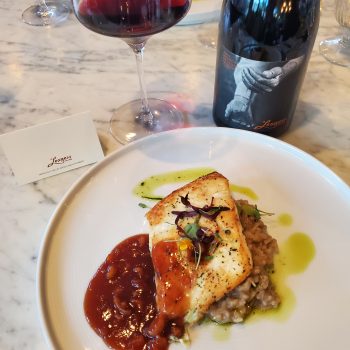
Avensole Winery
Avensole is a newer Temecula winery with a mash-up name of two Italian words meaning adventure
and sun. Opened in 2016 after an extensive renovation, the woman-owned winery is an inside-outside property. You walk the path through the lounging area, around gardens, statues and a man-made lake to reach the tasting room and restaurant with large patio area.
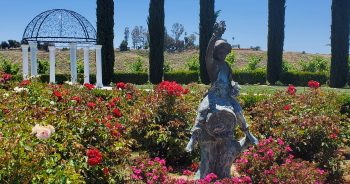
A highlight of the visit was lunch at the Avensole restaurant. Chef Taylor Israelsen takes full advantage of local produce and wine pairing opportunities. Note that the restaurant also serves excellent Sangria and refreshing cocktails including a Megamosa with Avenson sparkling Soirée Rosé for three or more.
We enjoyed Avensole Solea, a delicious and unusual blend of tempranillo, cabernet franc and merlot that paired well with a colorful starter of roasted and pickled cauliflower.
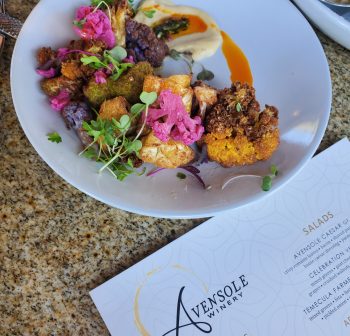
The original vineyard plantings of the property date from 1968. The well-awarded, smooth-on-the-palate Avensole South Slope Cabernet Sauvignon 2017 includes grapes from 30-year-old vines and paired well with the Avensole Angus beef burger with applewood smoked bacon.
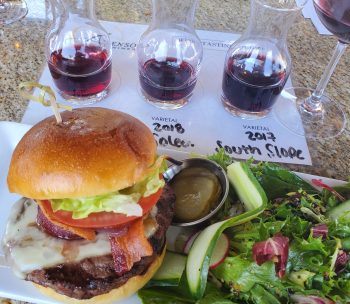
Wiens Cellars
Though Wiens Cellars wasn’t on our official itinerary, several of us requested a tour after tasting their Cabernet Sauvignon at a seminar presented by winemaker Brian Marquez. At the Wiens Reserve Tasting held in the cellar room, I liked their Reserve Chardonnay crafted in an elegant Burgundian style and their top-of-the-line 2019 Waxman Cabernet Sauvignon. Described as the Wiens ode to famous Opus One Cabernet Sauvignon in Napa, the wine was deep and rich with smooth tannins.
The Waxman Cabernet Sauvignon is also the favorite of owner David Steinhafel who bought the winery in 2022. The mergers and acquisitions finance executive had partnered with his father to find a new business venture. Upon visiting Wiens, Steinhafel told his Dad, “This is the winery we want with excellent wine and strong family heritage since 1996.” Since the Wiens family already planned to sell the business, Steinhafel bought the winery and wisely kept Joseph Wiens as director of winemaking.
The elegant ambiance of the reserve tastings is enhanced by shiny stainless-steel tanks and the first-in-the-U.S., Spanish rack system holding oak barrels. Tours and tastings on the expansive patio are popular.
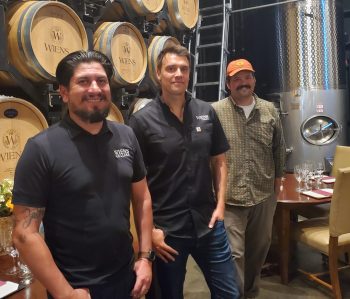
Peltzer Family Cellars
Charlie Peltzer represents the fifth generation of Southern California farmers. Petlzer’s wife Carrie is an interior designer, and her touch manifests in the vintage farm equipment and tractor collection in the event space fronting the winery.
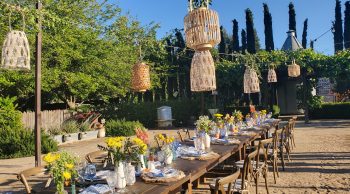
Peltzer’s great, great grandfather moved from Kansas to start a citrus grove in Anaheim. After the land was sold to Disneyland, Charlie’s father launched a Christmas tree farm.
In 2006, Charlie bought the Temecula property and planted grapes which he sold to his friend Nick Palumbo, owner of Palumbo Family Vineyards & Winery. In 2016 the Peltzers began making wine under the Peltzer Family Cellars label. The Peltzer Italian varietals such as Estate Barbera and Sangiovese captured my attention as did the Super Tuscan blend. The 2020 Feelin’ Cocky Tempranillo-Barbera-Syrah blend and the Aged Bourbon Barrel Zinfandel with wood notes are also crowd-pleasers and food friendly with dishes such as the Korean braised short ribs served at our dinner.
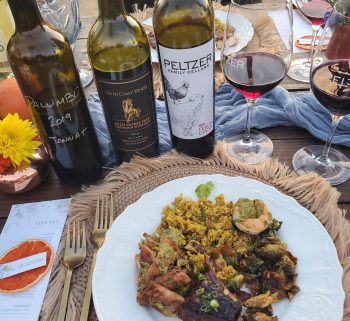
Robert Renzoni Vineyards
The Renzoni family winemaking heritage began in 1886 when Federico Renzoni began working at a winery in the Marche region of Italy. The great-grandfather of Robert Renzoni later emigrated to Rochester, NY and worked in the wine industry. After Depression era bootlegging, the family ran a successful wine distribution business. In the mid-1990s, the family sold the business and moved to San Diego.
Like many Southern Californians, Robert Renzoni often traveled to Temecula Valley for wine tastings. In 2006 he bought the winery property, planted vines and began making wine.
We toured Robert Renzoni Vineyards with Winemaker Olivia Bue who runs a meticulously clean cellar. Bue’s excellent palate shows in the fine balance of her wines.
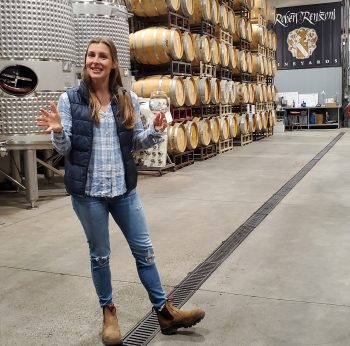
The refreshing and dry Renzoni Lyric Rosé, named for Robert’s daughter, is an excellent pairing with diverse appetizers. The Fiore of Fano, a velvety Super Tuscan red blend of Sangiovese and Bordeaux varietals, matched up to the truffle-scented pizza. The winery hosts a reasonably priced tasting of five wines on the patio or tasting room and daily lunch and weekend dinners at the estate Mama Rosa’s Trattoria.
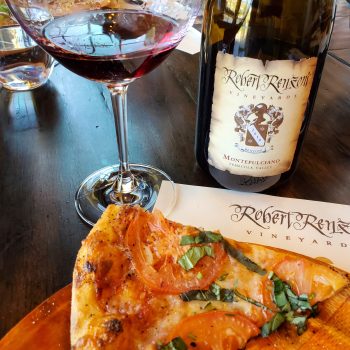
A sustainable, regenerative wine region
On his website, Robert Renzoni notes that his property was the first solar powered winery in Southern Calif. Temecula Valley wineries favor sustainable winery practices. Nick Palumbo of Palumbo Family Vineyards & Winery was a key participant in the 2002 California Code of Sustainable Winegrowing Practices. He shared a vignette about the potential of the next generation of Temecula Valley wine growers. “The local high school started a Regenerative Agriculture Club—and it is now one of the most popular clubs on campus.
“The local community college features a popular course in regenerative agriculture. Unlike the restrictive regulations of organic farming banning certain sprays and fertilizers, regenerative agriculture emphasizes care for the soil and vines in the best way for your vineyards, following outstanding cellar practices, and recharging employees and the community by giving our guests a positive experience at each winery, hotel, restaurant, and activity,” added Palumbo.
Palumbo noted that many students express the desire to stay in Temecula after school and talented winemakers are relocating to the area. In addition to a diversity of tasting options, excellent wines, and easy access to outdoor activities and adventures, visitors often stay at on-site resorts and hotels.
All these factors add up to Temecula Valley’s evolution as a blooming destination. Unlike the commercialization of some wine areas, Temecula wineries are friendly, accessible and largely undiscovered. Temecula Valley merits a slot on California wine travel bucket lists.
